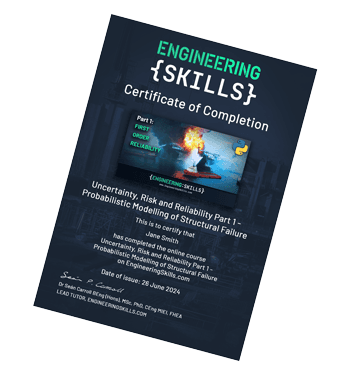
Uncertainty, Risk and Reliability Part 1 - Probabilistic Modelling of Structural Failure
Uncover the role uncertainty plays in structural behaviour with the First Order Reliability Method
- You will understand how the partial factor methodology captures uncertainty and the limitations inherent in this approach.
- You will understand how limit state functions can be developed to calculate the safety or reliability index.
- You will understand how to apply both the First Order Second Moment method and the First Order Reliability method of reliability analysis.
- You will have developed tools to efficiently apply these analysis techniques using Python.
This is the first course in a two-part series that delves into the role uncertainty plays in the modelling of structural behaviour.
The status quo - partial safety factors
In most design scenarios, we use partial safety factors to model the uncertainty associated with both structural capacity (strength) and demand (loading). When the factored-down capacity exceeds the factored-up demand by a suitable margin of safety, we don’t expect failure to occur.
Yet failures still occur - although thankfully with vanishingly small frequency in most well-regulated construction industries. That said, even if failure is avoided - as designers, we’re still left in the dark as to how far we actually are from that limit state.

Carola Bridge partial collapse in September 2024, Dresden
The standard approach can’t tell us how likely failure is or how this likelihood changes as the capacity and demand variables are altered. The partial factor approach gives us a binary outcome: pass or fail!
Getting to grips with uncertainty
This course aims to give you a clear understanding of how we can capture the influence of variability in strength and demand parameters and how this ultimately allows us to calculate the probability of failure.
We’ll start by exploring some fundamental concepts in reliability theory, introducing the concept of a Limit State Function and the Safety or Reliability Index. We’ll also review how uncertainty is typically captured in design - through the use of partial factors, a so-called semi-probabilistic or Level 1 approach.
First Order Second Moment (FOSM) Method
With a solid foundation established, we’ll begin discussing the First Order Second Moment method for estimating the probability of failure. This is the first of our fully probabilistic (Level 2) methods. It serves as a great introduction to safety index calculation and will help us get comfortable with the core concepts and workflow.
However, we’ll quickly see that we run into some significant limitations of the First Order Second Moment method - particularly as our limit state functions become more complex (non-linear).
First Order Reliability Method (FORM)
After identifying some of the limitations of the FOSM method, we’ll tackle a further development of this approach - the First Order Reliability Method. This is an iterative process that gives excellent results and is one of the most commonly used methods for assessing structural reliability today.

After completing this course, you’ll understand the often unseen and underappreciated significance that uncertainty plays in structural modelling. You’ll also have developed practical tools to estimate the probability of structural failure.
Who is this course for?
- Students and engineers who want to understand the influence of uncertainty on structural behaviour
- Students or engineers who are familiar with partial factor-based (code-based) design and would like to understand more advanced probabilistic techniques for assessing failure likelihood.
Prerequisites
- Only a basic knowledge of statistics and probability is assumed. We'll still cover everything from the groud up so don't worry if it's been a while since you've seen a probability density function!
- We'll use Python in this course, but mainly just as a fancy calculator - so don't worry if your new to Python. Check out these lectures here and here to get yourself setup with Python on your own machine. I'll explain all of the Python as we use it so you'll be able to pick it up as you work alongside me.

Download your personalised Certificate of Completion once you’ve finished all course lectures.
Applying for jobs? Use your Certificate of Completion to show prospective employers what you’ve been doing to improve your capabilities.
Independently completing an online course is an achievement. Let people know about it by posting your Certificate of Completion on your Linkedin profile or workplace CPD portfolio.

